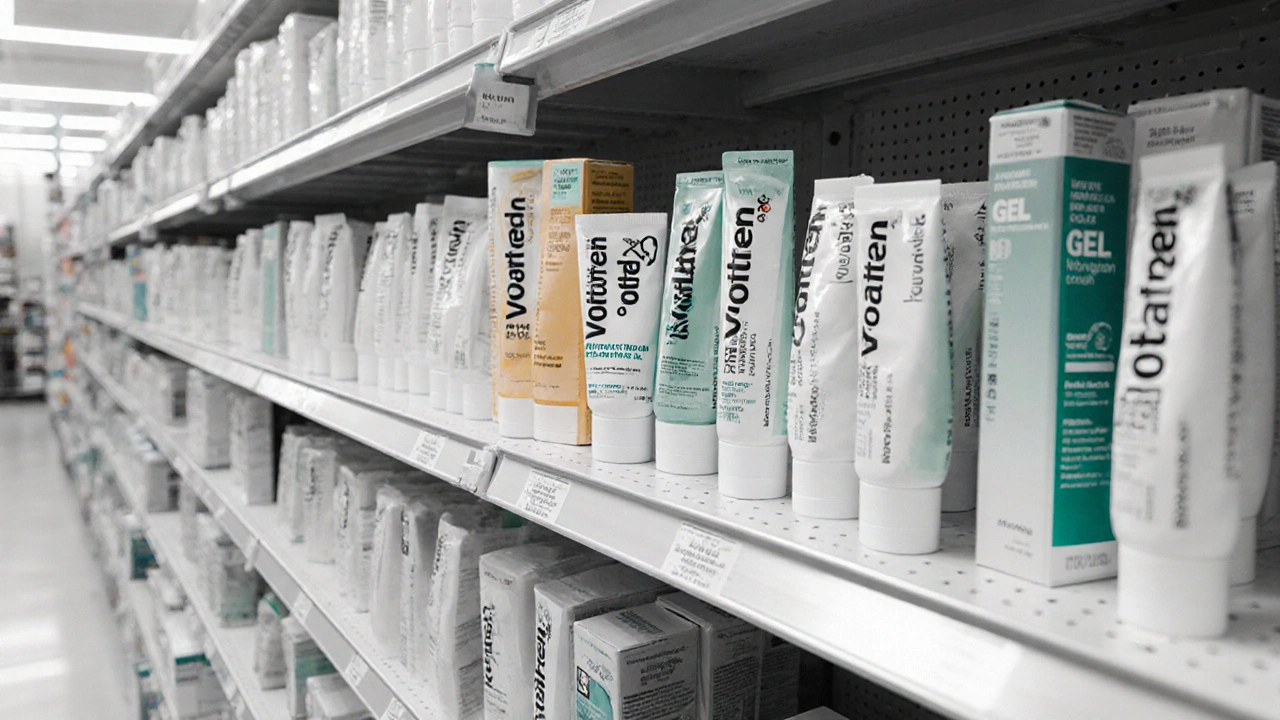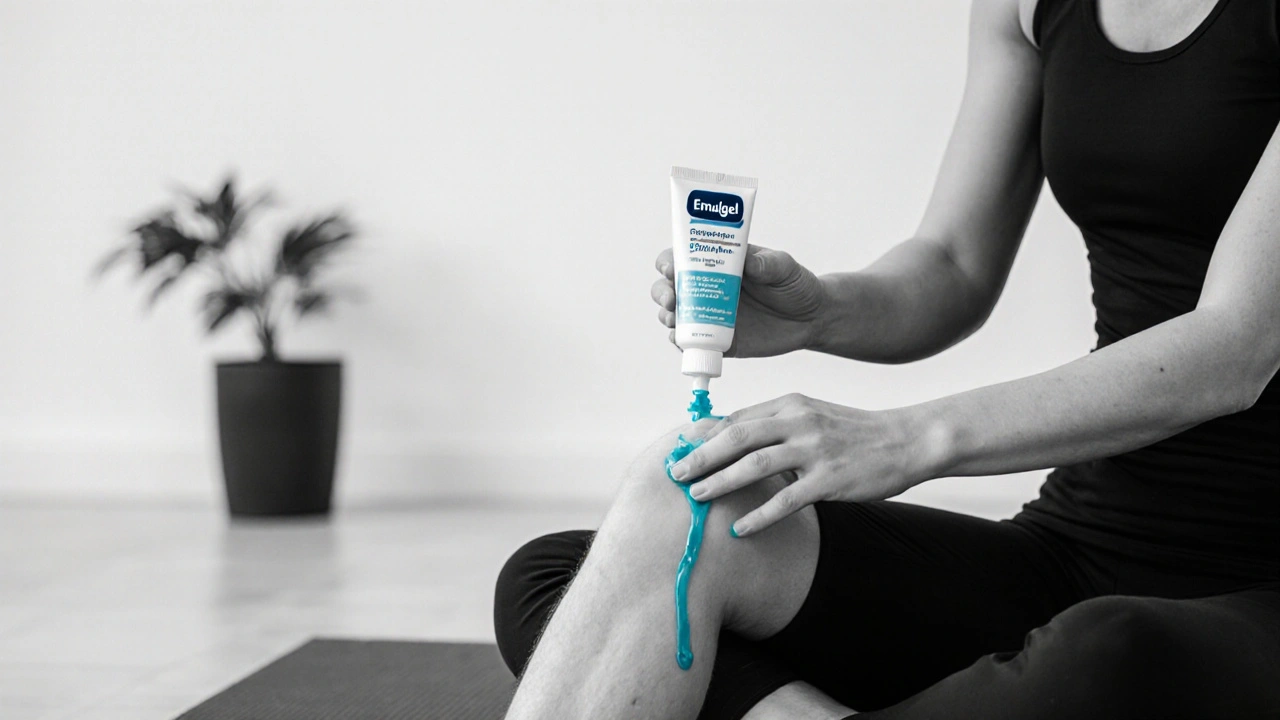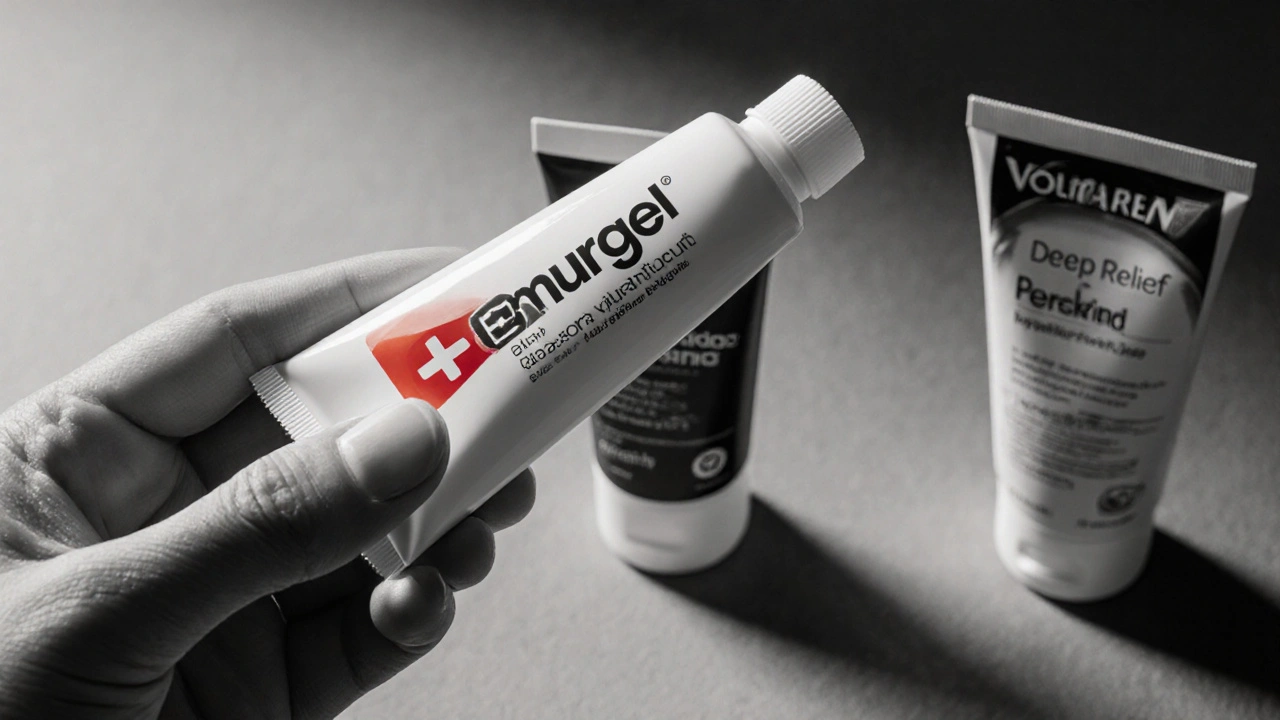Pain Gel Selector Tool
Find Your Perfect Pain Gel
This tool helps you choose the best topical pain gel based on your pain type, skin sensitivity, and budget considerations. Select your options below to get personalized recommendations.
Quick Summary
- Emulgel delivers 1% diclofenac and is ideal for short‑term joint pain.
- Voltaren Gel provides a similar 1% diclofenac concentration but spreads more easily.
- Ibuprofen‑based gels (Deep Relief, Nurofen Gel) work better for muscular aches.
- Ketoprofen gel (Perskind) is strong on inflammation but can sting on broken skin.
- Choose based on target tissue, skin tolerance, and price.
When you need fast relief for sore knees, sprained ankles, or aching elbows, a topical gel can be a game‑changer. Emulgel (Diclofenac) is a topical non‑steroidal anti‑inflammatory drug (NSAID) that delivers diclofenac directly to the inflamed area. It’s been on Australian shelves for over a decade, but the market now offers a handful of alternatives that claim similar or better results. This guide lines up the most common gels, compares their active ingredients, strengths, price points, and side‑effect profiles, and helps you decide which one fits your lifestyle.
Why Topical NSAIDs Matter
Oral NSAIDs flood your whole system, which can upset the stomach or affect kidney function, especially with long‑term use. A gel applied to the skin stays mostly local, delivering a high concentration right where the pain originates while keeping systemic exposure low. That’s why doctors often recommend a topical diclofenac or ibuprofen gel for mild‑to‑moderate musculoskeletal pain.
Core Attributes to Compare
Before diving into individual products, keep these five attributes in mind. They’ll show up in the comparison table and guide your decision‑making.
- Active ingredient & concentration: Determines anti‑inflammatory potency.
- Formulation base: Gel vs cream vs patch affects spreadability and skin feel.
- Onset of relief: How quickly you feel the effect.
- Typical price (AU$) for a 30g tube: Influences long‑term affordability.
- Common side effects: Stinging, rash, or rare systemic reactions.
Side‑by‑Side Comparison
| Product | Active Ingredient & Strength | Formulation Base | Typical Onset | 30g Price (AU$) | Common Side Effects |
|---|---|---|---|---|---|
| Emulgel (Diclofenac) | Diclofenac sodium 1% | Gel | 30‑45min | 13.99 | Mild skin irritation, rare GI upset |
| Voltaren Gel | Diclofenac sodium 1% | Gel (more fluid) | 20‑30min | 15.50 | Transient burning, occasional allergic rash |
| Deep Relief (Ibuprofen) | Ibuprofen 5% | Cream | 40‑60min | 12.75 | Skin tingling, rare systemic NSAID effects |
| Nurofen Gel | Ibuprofen 5% | Gel | 35‑50min | 13.20 | Local redness, slight headache |
| Perskind (Ketoprofen) | Ketoprofen 2.5% | Gel | 25‑40min | 16.00 | Stinging on open wounds, occasional dermatitis |

Deep Dive: When to Choose Emulgel
Emulgel (Diclofenac) shines in three scenarios:
- Localized joint pain-knees, elbows, and ankles where you need a concentrated dose without mess.
- Short‑term flare‑ups-the 30‑45minute onset gives quick comfort for sports injuries.
- Skin sensitivity to ibuprofen-diclofenac tends to cause less burning than ibuprofen gels for some users.
The gel’s slightly thicker texture keeps it in place, which is handy if you’re moving around a lot after application. However, that same thickness may feel sticky if you apply more than the recommended 4g per joint.
Alternative Profiles
Voltaren Gel is basically a thinner sibling of Emulgel. Because it spreads easily, you can cover larger surface areas (like a whole thigh) with less product. The trade‑off is a higher price and a slightly higher chance of transient burning on very thin skin.
Ibuprofen‑based creams (Deep Relief, Nurofen Gel) are gentler on the skin but need a higher percentage (5%) to match diclofenac’s anti‑inflammatory power. If your pain stems from sore muscles rather than joint inflammation, ibuprofen gels often feel cooler and more soothing.
Ketoprofen gel (Perskind) packs a punch with 2.5% ketoprofen, which can be stronger than diclofenac for severe inflammation. The downside is a more noticeable sting on compromised skin, so it’s best for intact, healthy epidermis.
Price & Accessibility Check
All the products above are available over the counter at major Australian pharmacies and most supermarkets. Emulgel and Voltaren sit in the $14‑$16 range for a 30g tube, making them comparable. Ibuprofen gels are a few cents cheaper, while ketoprofen tops the price chart.
If you’re on a tight budget and need to treat multiple joints, buying the generic store brand of ibuprofen gel can stretch your dollars, though you may sacrifice a millimetre of potency.

Safety Tips & Common Pitfalls
- Never apply gels to broken skin, open wounds, or mucous membranes; absorption spikes and irritation rises.
- Avoid simultaneous use of oral NSAIDs without medical advice; additive systemic exposure can strain kidneys.
- Wash hands after application to prevent accidental eye contact.
- Limit daily use to the label‑recommended amount (usually 4g per affected area, up to 3‑4 times a day).
- If redness or burning lasts more than 30minutes, discontinue and consult a pharmacist.
Choosing the Right Gel for You
Use the decision tree below to narrow down your choice:
- Is the pain mainly in a joint (knee, elbow, ankle)?
- Yes → Emulgel or Voltaren are strong candidates.
- No (muscle soreness) → Consider ibuprofen gels.
- Do you have sensitive skin that reacts to a burning sensation?
- Yes → Emulgel (lower sting) or ibuprofen cream.
- No → Ketoprofen gel can be tried for tougher inflammation.
- Is cost a deciding factor?
- Yes → Generic ibuprofen gel (often
- No → Choose based on onset speed; Voltaren offers the fastest spread.
- Yes → Generic ibuprofen gel (often
Remember, no gel replaces proper physiotherapy or medical evaluation for chronic conditions. Use them as a bridge to get you moving again.
FAQs
Can I use Emulgel on a sprained ankle?
Yes, applying a thin layer (about 2g) 3‑4 times a day can reduce swelling and pain. Avoid the area if the skin is torn or bruised.
How long should I wait before applying another dose?
Space applications at least 4‑6hours apart unless your doctor advises otherwise.
Is it safe to combine a topical gel with oral NSAIDs?
Generally not recommended for long periods because the combined dose can affect kidney function. Short‑term overlap for severe pain should be discussed with a healthcare professional.
Will the gel work on rheumatoid arthritis?
Topical NSAIDs can relieve joint tenderness in early‑stage rheumatoid arthritis, but they don’t replace disease‑modifying drugs. Use them as adjunct therapy under doctor supervision.
Do any of these gels contain parabens or other preservatives?
Most Australian formulations, including Emulgel and Voltaren, use phenoxyethanol and methylparaben as preservatives. Check the ingredient list if you have sensitivities.
Bottom Line
If you need a fast‑acting, joint‑focused gel, Emulgel (Diclofenac) remains a solid, cost‑effective choice. For larger skin areas or slightly quicker spread, Voltaren Gel takes the edge. Muscle aches are better served by ibuprofen gels, while ketoprofen offers the strongest anti‑inflammatory punch at a higher price and sting risk. Match the product to your pain type, skin tolerance, and budget, and you’ll get the most relief for the least hassle.






Comments
Topical diclofenac gels aren't the miracle they claim to be; they just sit on your skin and pretend to work. I mean, sure, they cut down on stomach issues, but you still end up rubbing a sticky mess on a sore knee. Everybody jumps on the Emulgel hype like it's the only option, yet the price tag says otherwise. Honestly, I’d rather stretch before a run than waste money on a gel that takes forever to soak in.
Topical NSAIDs, when used wisely, can be a soothing bridge between pain and relief 😊. Imagine the comfort of a gel that slides onto inflamed joints, delivering targeted action without enlisting your liver in the process. It’s a reminder that sometimes the simplest solutions, like a thin layer of medicine, carry profound wisdom. The gentle hum of healing, whispering through the skin, can feel almost poetic. Embrace the calm that follows, and let the discomfort fade into memory 😊.
Indeed, the formulation base of each gel matters-a gel spreads faster, a cream lingers longer!!! The thicker texture of Emulgel keeps it in place, which is handy for active folks!!! Plus, the 1% diclofenac concentration strikes a solid balance between potency and safety!!! I appreciate the collaborative spirit of sharing these nuances with the community!!!
i think ibuprofen gels feel cooler on sore muscles and they dont sting as much. they are a good budget option
Don’t let the glossy ads fool you-these over‑the‑counter gels are part of a grand pharma scheme to keep us buying forever. The big corporations push diclofenac as the gold standard while quietly inflating the price like a hidden tax on our aches. If you look beyond the shiny packaging, you’ll see how they manipulate our trust with fake “clinical superiority”. It’s a patriotic duty to question who really profits when we rub a tube of gel on our joints. In the end, the real inflammation is the one in our wallets.
OMG this gel business is a total circus!!! they slap on fancy names like Emulgel and Voltaren and expect us to worship them!!! but the sting on broken skin is real and it hurts like hell!!! i cant even stand the burning sensation on my thin ankle skin!!! this is why we need to break free from the pharma puppeteers!!!
Choosing the right gel really comes down to the specific tissue you’re treating and how your skin reacts. For joint pain, a diclofenac gel such as Emulgel offers quick onset and solid anti‑inflammatory power. If you have more muscular soreness, an ibuprofen‑based cream can feel soothing and often costs less. Always follow the label dosage and wash your hands after application to avoid accidental contact with eyes.
The journey to pain‑free movement can feel like an epic saga, yet the right topical ally can be your trusty sidekick. Emulgel, with its 1% diclofenac punch, swoops in to calm inflamed joints faster than a knight charging into battle. When the gel cools your skin, imagine a wave of relief that carries away the ache like a sunrise dispelling night. Keep your spirit bright, trust the science, and let each application write a victorious chapter in your healing story.
Topical gels are just a marketing ploy
Let us consider the ethical landscape of topical NSAIDs, a terrain often overlooked by the casual consumer.
First, the premise that a gel can deliver the same therapeutic effect as oral medication is a simplification that neglects systemic pharmacokinetics.
Second, the regulatory oversight that permits these over‑the‑counter products is, in many respects, a lenient concession to corporate lobbying.
Third, the environmental impact of mass‑produced gel tubes, from plastic waste to chemical runoff, betrays a hidden cost to the planet.
Fourth, the psychological reliance on a quick fix fosters a culture of complacency, discouraging holistic approaches like physiotherapy and movement education.
Fifth, the price disparity between generic ibuprofen creams and branded diclofenac gels illustrates a profit‑driven market segmentation.
Sixth, the marketing narratives glorify rapid relief while downplaying the modest risk of skin reactions and rare systemic absorption.
Seventh, the very act of massaging a gel into inflamed tissue can provide a placebo benefit, yet consumers are seldom informed of this nuance.
Eighth, the moral responsibility of pharmacists to counsel patients is often reduced to a perfunctory statement, undermining informed consent.
Ninth, the scientific community continues to debate the comparative efficacy of these agents, a discussion that should be transparent to the public.
Tenth, the cultural shift toward self‑medication reflects broader societal trends of individualism, for better or worse.
Eleventh, we must ask whether the convenience of a tube outweighs the cumulative societal costs described above.
Twelfth, the answer lies in educated choice, critical scrutiny, and a willingness to seek alternative modalities when appropriate.
Thirteenth, empower yourself with knowledge, read the fine print, and remember that true health extends beyond a temporary balm 😊.
Finally, let us not be swayed by glossy packaging, but instead champion a balanced, ethical approach to pain management 🌟.
Honestly, I could scroll past these gel reviews forever and still feel the same indifference. Yet here I am, typing out a half‑hearted rant because the pressure to comment is real. The whole market feels like a circus of overpriced tubes and empty promises. If you ask me, just stretch and move-no gel needed.
i've seen how different cultures treat joint pain, from herbal poultices to modern gels, and each has its own wisdom. the key is respecting tradition while embracing science, not abandoning one for the other. Emulgel might work well for some, but it's not the universal answer. we should share knowledge across borders and let people choose what feels right for their bodies.